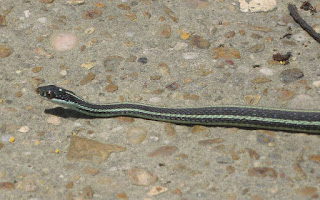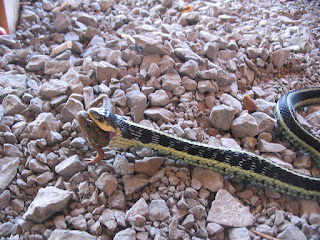The Garter snake is a Colubrid snake genus (Thamnophis) common across North America, ranging from Alaska and Canada to Central America. It is the single most widely distributed genus of reptile in North America. The garter snake is also the Massachusetts state reptile.
There is no real consensus on the classification of species of Thamnophis. Disagreement among taxonomists and sources, such as field guides, over whether two types of snakes are separate species or subspecies of the same species is common. They are also closely related to the snakes of the genus Nerodia, and some species have been moved back and forth between genera.
Garter snakes have complex systems of pheromonal communication. They can find other snakes by following their pheromone-scented trails. Male and female skin pheromones are so different as to be immediately distinguishable. However, sometimes male garter snakes produce both male and female pheromones. During mating season, this fact fools other males into attempting to mate with them. This causes the transfer of heat to them in kleptothermy which is an advantage immediately after hibernation so allowing them to be more active. Male snakes giving off both male and female pheromones have been shown to garner more copulations than normal males in the mating balls that form at the den when females emerge into the mating melee.
If disturbed, a garter snake may coil and strike, but typically it will hide its head and flail its tail. These snakes will also discharge a malodorous, musky-scented secretion from a gland near the cloaca. They often use these techniques to escape when ensnared by a predator. They will also slither into the water to escape a predator on land. Hawks, crows, raccoons, crayfish and other snake species (such as the coral snake and king snake) will eat garter snakes, with even shrews and frogs eating the juveniles.
Being heterothermic, like all reptiles, garter snakes bask in the sun to regulate their body temperature. During hibernation, garter snakes typically occupy large, communal sites called hibernacula. These snakes will migrate large distances to brumate.







